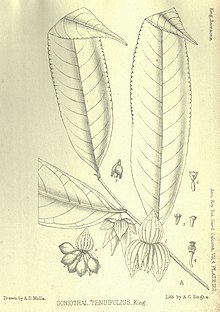Goniothalamus tenuifolius
Goniothalamus tenuifolius is a species of plant in the family Annonaceae. It is native to Peninsular Malaysia, Thailand and Vietnam.[3] George King, the British botanist who first formally described the species, named it after its slender (tenui- in Latin) leaved (-folius in Latin) foliage.[4]
| Goniothalamus tenuifolius | |
|---|---|
 | |
| Botanical illustration of Goniothalamus tenuifolius.[1] | |
| Scientific classification | |
| Kingdom: | Plantae |
| Clade: | Tracheophytes |
| Clade: | Angiosperms |
| Clade: | Magnoliids |
| Order: | Magnoliales |
| Family: | Annonaceae |
| Genus: | Goniothalamus |
| Species: | G. tenuifolius |
| Binomial name | |
| Goniothalamus tenuifolius | |
| Synonyms | |
|
Goniothalamus caudifolius Ridl. | |
Description
It is a bush reaching 1.8-2.4 meters in height. Its young branches are hairless and dark colored. Its petioles are 5.1 millimeter long. Its slender, membranous, oblong to lance-shaped leaves are 11.4-17.8 by 2.5-4.4 centimeters with short tapering tips and pointed bases. Its leaves have 8-11 pairs of secondary veins emanating from their midribs. Its drooping, solitary flowers are born on pedicels in axillary positions. The pedicels are 0.9-1.1 centimeters long with 2 basal bracts. Its membranous, hairless, oval, green sepal are 0.7–1.9 by 0.5–1.5 centimeters with pointed to tapering tips. Its flowers have 6 petals in two rows of three. The white, lance-shaped, thin, leathery outer petals are 1.0–4.0 by 0.4–1.5 centimeters with tapering tips. The outer petals are covered in fine hairs. The oval inner petals are 5–14 by 3–8 millimeters with tapering tips. The outer petals are covered in fine hairs. Its flowers have few narrow, short ovaries, each with 1-2 ovules. Its long styles are thicker toward their apex. Its funnel-shaped stigma have a toothed edge. Its fruiting pedicel are 3-18 millimeters long. Its oval fruit 0.7 1-1.3 centimeters long and have persistent calyx. Its fruit have 1-2 seeds.[5][6]
Reproductive biology
The pollen of G. tenuifolius is shed as permanent tetrads.[7]
Habitat and distribution
It has been observed growing in lowland forests at elevations of 50 to 900 meters.[6]
Uses
Extracts from the leaves have been reported to have free radical scavenging activity using in vitro tests.[8]
References
- King, George (1893). "Anonaceae of British India". Annals of the Royal Botanic Garden, Calcutta. 4: plate 122. Retrieved June 21, 2020.
- Kochummen, K.M. (1998). "Goniothalamus tenuifolius". IUCN Red List of Threatened Species. 1998: e.T31711A9653424. doi:10.2305/IUCN.UK.1998.RLTS.T31711A9653424.en. Retrieved October 4, 2019.
- "Goniothalamus tenuifolius King". Plants of the World Online. The Trustees of the Royal Botanic Gardens, Kew. n.d. Retrieved February 1, 2019.
- Stearn, William (2004). Botanical Latin. Portland, Ore. Newton Abbot: Timber Press David & Charles. ISBN 9780881926279.
- King, George (1892). "Materials for a Flora of the Malay Peninsula". The Journal of the Asiatic Society of Bengal. 61 (pt.2:no.1, 3): 1–130.
- Saunders, Richard M. K. (2003). "A synopsis of Goniothalamus species (Annonaceae) in Peninsular Malaysia, with a description of a new species". Botanical Journal of the Linnean Society. 142 (3): 321–339. doi:10.1046/j.1095-8339.2003.00177.x. ISSN 1095-8339.
- Saunders, Richard M. K.; Chalermglin, Piya (2008). "A synopsis of Goniothalamus species (Annonaceae) in Thailand, with descriptions of three new species". Botanical Journal of the Linnean Society. 156 (3): 355–384. doi:10.1111/j.1095-8339.2007.00762.x. ISSN 0024-4074.
- Likhitwitayawuid, Kittisak; Klongsiriwet, Chaweewan; Jongbunprasert, Vichien; Sritularak, Boonchoo; Wongseripipatana, Samphan (2006). "Flavones with free radical scavenging activity from Goniothalamus tenuifolius". Archives of Pharmacal Research. 29 (3): 199–202. doi:10.1007/BF02969393. ISSN 0253-6269.
